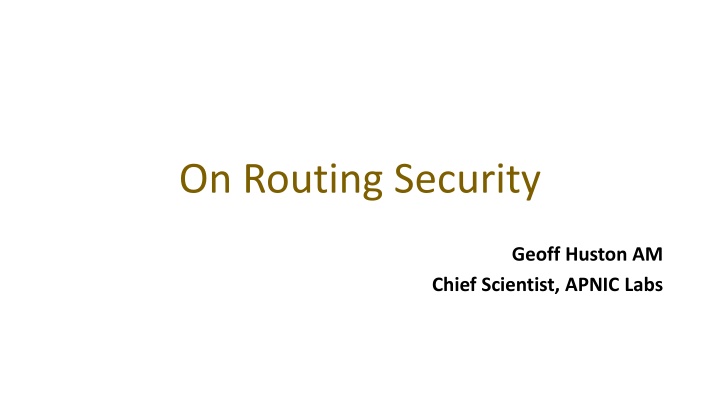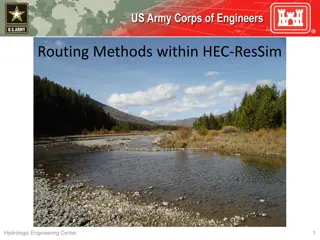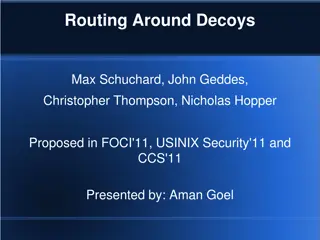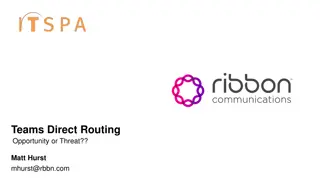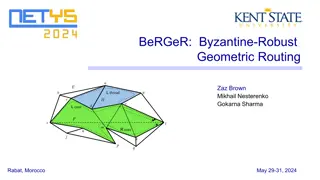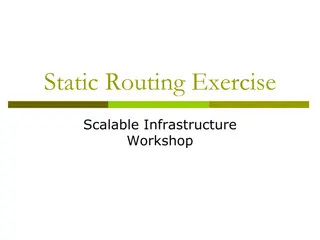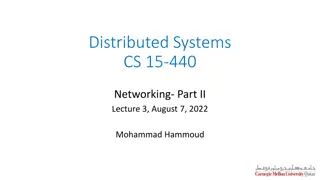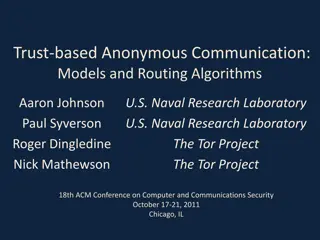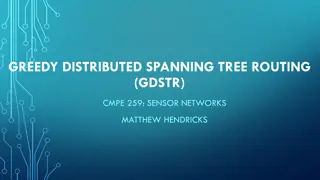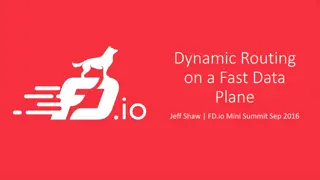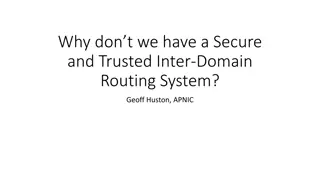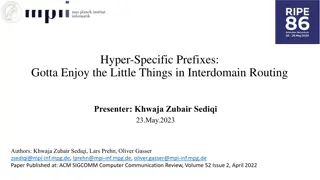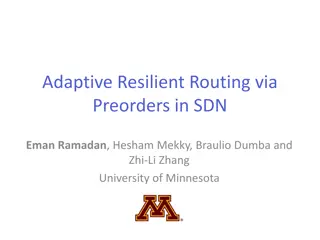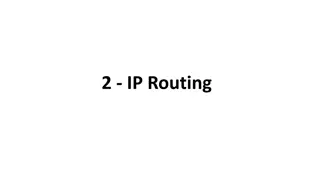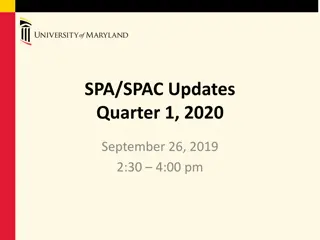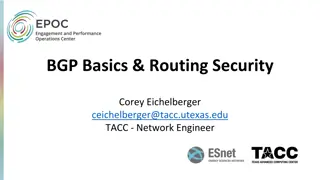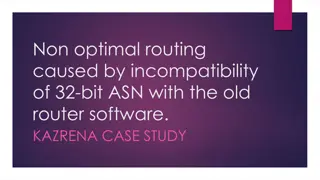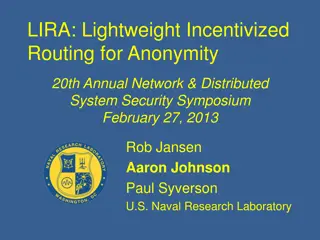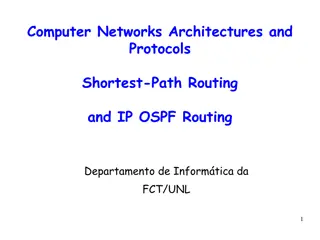On Routing Security
In this content, Geoff Huston, the Chief Scientist at APNIC Labs, shares valuable insights on routing security. He emphasizes the importance of not overlooking tools like RPKI in maintaining a secure routing environment. Highlighting real examples of routing attacks, the content delves into the significance of honest appraisal in engineering practices to combat malicious incidents effectively.
Download Presentation

Please find below an Image/Link to download the presentation.
The content on the website is provided AS IS for your information and personal use only. It may not be sold, licensed, or shared on other websites without obtaining consent from the author.If you encounter any issues during the download, it is possible that the publisher has removed the file from their server.
You are allowed to download the files provided on this website for personal or commercial use, subject to the condition that they are used lawfully. All files are the property of their respective owners.
The content on the website is provided AS IS for your information and personal use only. It may not be sold, licensed, or shared on other websites without obtaining consent from the author.
E N D
Presentation Transcript
On Routing Security Geoff Huston AM Chief Scientist, APNIC Labs
Acknowledgement To George Michaelson for some of the material used here!
Dont stop signing ROAs! This is notsaying RPKI is wrong and you shouldn t use it Not at all! We have only a few tools to help us with keeping routing together, so we shouldn t let the perfect become the enemy of the good
Dont stop signing ROAs! But If we can t be honest in appraising the effectiveness of these various approaches then we ve walked away from evidence-based engineering and headed right into the fantasy marketing department!
Routing incidents comes in all shapes and sizes Some are malicious attacks intended to generate victims But most are incidents we inflict upon ourselves in various inept, random and accidental ways
What do real routing attacks look like? Ethereum 2018 Effort that subverted the DNS, to take control over an Ethereum wallet Subverted routing for Route 53 Authoritative DNS servers via more specific announcements for their own DNS server This attack used a different origin AS (AS10297), but as it was a more specific prefix, they could ve faked the original (AS16509) if we were doing origination checks at the time Replied SERVFAIL for domains it wasn t attacking Misdirected DNS for myetherwallet.com to intercepting website If users clicked through a this is a false certificate warning, then their Ethereum wallet was drained It was fast - the attack was all over in a couple of hours! The DNS attack could ve been defeated by: Users NOT clicking through a bad cert warning Using DNSSEC signing for the myetherwallet.com domain Using RPKI ROA with a maxlength parameter
What do real routing attacks look like? Attacks tend to be multi-part these days Subvert the infrastructure enough to fool a DNS registrar Take over the name registration and delegate the name Re-sign the name with DNSSEC Grab a cert from an CA You re in! Or Fool a CA s automated tests to get a fake certificate By a targeted attack on the DNS resolution infrastructure Then attack routing and use the fake cert to redirect users You re in!
And we would all like to handle this better So we take one or two proto-typical attacks and we design tools to prevent those attacks It s simpler and focusses the effort to mitigate the issue And we hope that the ones we selected as attack examples were really good exemplars of what we are trying to prevent
The Archetypical BGP Incident February 2008
How? AS36561 (YouTube) was announcing 208.65.152.0/22 AS17557 (Pakistan Telecom) announced 208.65.153.0/24 In BGP more specific prefixes win every time so if a network heard the /24 then it believed it as a refinement to the encompassing /22 This was a failure in filtering. But while (some) ISPs filtered their customers, the practise of applying filters to internal wholesale connections was less common. So the false route propagated from a regional transit provider and everyone else believed it.
But that was 14 years ago Are we getting better at filtering? Not really February 2021 AS 136168 (Campana MYTHIC) in Myanmar implements a government directive and propagates a more specific of Twitter s service address (104.244.42.0/24) Twitter had lodged an RADB entry and if others were filtering on this RADB entry, then that would ve stopped the false route propagating But not enough folk perform transit filtering on RADB data So the route propagated outward to AS132132, AS61292, AS4844, AS8106 and AS23673 and onward to ~40 other ASes who don t filter based on RADB entries
Maybe we need more than Route Registries We ve been using Route Registries as the foundation of route filtering since the NSF-funded Routing Arbiter project of the early 90 s The problem with route registries is that they require intense feeding and watering, as they develop bitrot very quickly Surely we could use the Awesome Power of Digital Cryptography and automate the heck out of this and not just rely on hand-curated lists and fallible human operators?
Meanwhile, over the ditch in RIR Land We were looking at how to provide testable authenticity in supporting whois queries in the address registries The RIRs were aware that many ISPs used these registries as a source of authenticity to process requests to route BYO prefixes from customers, and ISPs were keen to push the authenticity problem off to literally anyone else! Maybe we could inject this testable authenticity directly into the routing system to literally make it impossible to lie!
All Hail RPKI! Use the RIR registry as the source of authority Registry operator certifies a resource holder through a public key certificate Resource holders can digitally sign attestations with their resources The signature also means that they are acknowledged resource holder and the resource is validly allocated or assigned Validation of a signature means that the attestation is genuine, complete and current We can feed this into the routing system
RPKI, meet BGP! Separate out origination and propagation and treat them separately Origination is protected by using a signed authority issued by the prefix holder to authorise an AS to originate a route or set of routes (ROA)
ROA Production Internet-wide average 35% of routes 45% 60% https://stats.labs.apnic.net/ROAS
RPKI, meet BGP! Separate out origination and propagation and treat them separately Origination is protected by using a signed authority issued by the prefix holder to authorise an AS to originate a route or set of routes (ROA) Then you assemble these digital authorities and generate a filter list in the router and drop all routing announcements that are invalid
Drop RoV-Invalid routes Internet-wide average 16% of users 45% of users 65% of users https://stats.labs.apnic.net/RPKI
RPKI, meet BGP! Separate out origination and propagation and treat them separately Origination is protected by using a signed authority issued by the prefix holder to authorise an AS to originate a route or set of routes (ROA) Then you assemble these authorities and generate a filter list in the router and drop announcements that are invalid Propagation is a problem Wholistic approaches that attempt to link the AS path to the propagation of an update (BGPSEC) resist piecemeal deployment and are crypto-intensive BGPSEC is largely DOA Piecemeal approaches offer more limited protections that limit the plausibility of some forms of lies
RPKI, meet BGP! It s not an entirely comfortable match between RPKI and BGP The hop-by hop aspects of BGP (withdrawals, communities) are not possible to validate against an origination root cause Routing is backwards BGP does NOT select the forwarding path It creates a partial topology by passing reachability in the reverse direction And that s all An AS Path describes the route propagation path, not the packet s forwarding path What matters is forwards Our concern is with the forwarding path And that s what we can t check from the routing system
So securing routing is hard But is it enough? What do we see in terms of incidents in todays network? Would RPKI in BGP defend the network from such incidents in any case? Lets look at some more examples of incidents and outages that induced routing anomalies
Facebook Meta, October 2021 Lost route to nameservers Used a single route to all nameservers Used short cache lifetime DNS records Lost sight of all 4 anycast nameservers for @facebook.com Lost access to secure entry tokens in @facebook.com Even if they d had DNS, NLRI routes to offline server surface would have looked pretty bad Web service sending what? 6-8 hour outage (5nines is 5min/year unplanned outage, so that s 72 years of credit for 5nines!) Huge amounts of Africa functionally offline for business WhatsApp for money exchange 3 billion Facebook users were totally disconnected from the platform over this time
Own Goal Syndrome Yes, there was a BGP incident at the heart of this It was a withdrawal that isolated the authoritative nameservers for facebook.com But it was not an attack It was an internal operational error And RPKI/BGPSEC cannot protect inadvertent route withdrawals in any case And the outage was multiplied by the withdrawal of the DNS records because of cache expiry And made worse because the outage also locked them out of their facilities (!)
More recent Own Goals June 2021 A certain customer configuration change that was flagged as valid triggered a complete platform crash in their Varnish platform Varnish is NOT a Fastly-developed platform it is open source developed by a Norwegian newspaper site July 2021 A config change had a format error that disabled the front end load balancer, that disabled their DNS steering and took out the platform Obviously, not a routing problem
Own Goals are insanely common! But what about collateral damage?
Collateral Damage November 2018, MainOne in Nigeria had a configuration error that leaked ~200 Google Cloud routes to various transits, including China Telecom, who propagated the routes onward Two hours later Main One Leaked Cloudflare routes along the same transit paths Would RPKI have helped here? Assuming this was a path leak, then no, not really It s a routing policy violation, not a protocol / announcement correctness issue
Collateral Damage June 2019 AS33154 (DQE Communications, US) had a Noction BGP Optimizer that announced a set of more specifics to its customer AS396531 (Allegheny Technologies) who readvertised these routes to AS7012 (Verizon) a Large Tier 1 transit network who was not performing route filtering A large set of routes were redirected along this mule track detour, including AWS and Cloudflare, causing major disruption RPKI? Maybe depends on the use of ROAs with maxlength to reject more specifics
Other Recent Collateral Damage incidents IBM cloud outage, June 2020 external provider leak Unnamed external provider, 2+ hours, multiple regions. RPKI? Possibly, possibly not!
More TWC, Rogers, Charter, July 2020 Small ISP deploying BGP optimisers leaked routes Propagated by Telia
Yes, More Vodafone India prefix leak, April 2021 30,000 prefixes mistakenly leaked Google, Akamai, Edgecast, Deutsche Telekom, TIM, Claro, Orange, Telefonica), Vodafone itself (worldwide) amongst others
Commonalities Its an indirect sideswipe But there is still a service loss, loss of business, customer/SLA effects Yes, some of these could have been avoided by a ROA with careful use of maxlength But ROAs are universal, not context specific They don t come with an apply here, but not there, sticker If ROAs allow you to accept more specifics, then they won t stop you propagating them onward But other incidents are policy routing issues relating to leakage, not synthetic routes
Does Network Automation help here? Yes - and No A config change can flip the state of all components of the network all at once amplifying the potential for a problem to be network wide though just one command transaction Less margin for error and greater potential for damage. And automated scripts within these system can generate completely unanticipated outcomes! Some network managers see the purchase of an automated network management system as a compatible substitute for a skilled workforce a stunning triumph of unwarranted optimism over reality!
Does RPKI help here? Well, yes, a bit, but its not the full picture: And adding more moving parts to a complex system does not make it more robust it often achieves the exact opposite RPKI uses a single rule set that is applied everywhere it does not provide context-specific conditional application Many route leaks are a policy violation, not a protocol violation And policies are often contextual, not universal Some of the routing issues are the result of loss of a synchronised forwarding state, and BGP (and RPKI) don t and can t enforce synchronicity in state across BGP speakers We ve seen ghost routes in BGP that have been persistent for years!
So whats the answer? We continue to push larger route sets and larger policy agendas onto the routing system And because clue is finite, we are automating more and more of network management to make up for a serious skill gap Which creates brittleness in the routing that is prone to fail in unsafe states that can t be readily recovered How can we make routing more robust?
Routing is Difficult The most complicated computation ever attempted by mankind is the global distributed routing algorithm that runs the Internet. In fact, if anybody thought about it very hard, before we started, they would've been too scared to try. Ah, because it runs in near real-time, it's an online algorithm, it runs on a multimillion node multicomputer, of an arbitrary topology, built by lots of people who have never met each other. Right? And, it's a very very complex computation because it's piecewise constructive, there is a lot of local consistency constraints, there is a bunch of global correctness criteria that are occasionally satisfied, and yet the thing mostly works. Which is astounding, when you actually look at what's going on. Mike O Dell, 2000 (http://www.dtc.umn.edu/~odlyzko/isources/odell-transcript.txt)
Routing Security is not a solved problem I m not sure we really know what we really mean when we talk of routing security And I m not sure that operationally focussed piecemeal incrementalism is really helping here with the bigger picture of tackling routing robustness and stopping these various routing mishaps This is remains a problem space that would benefit from further research and experimentation And research funding of course!
